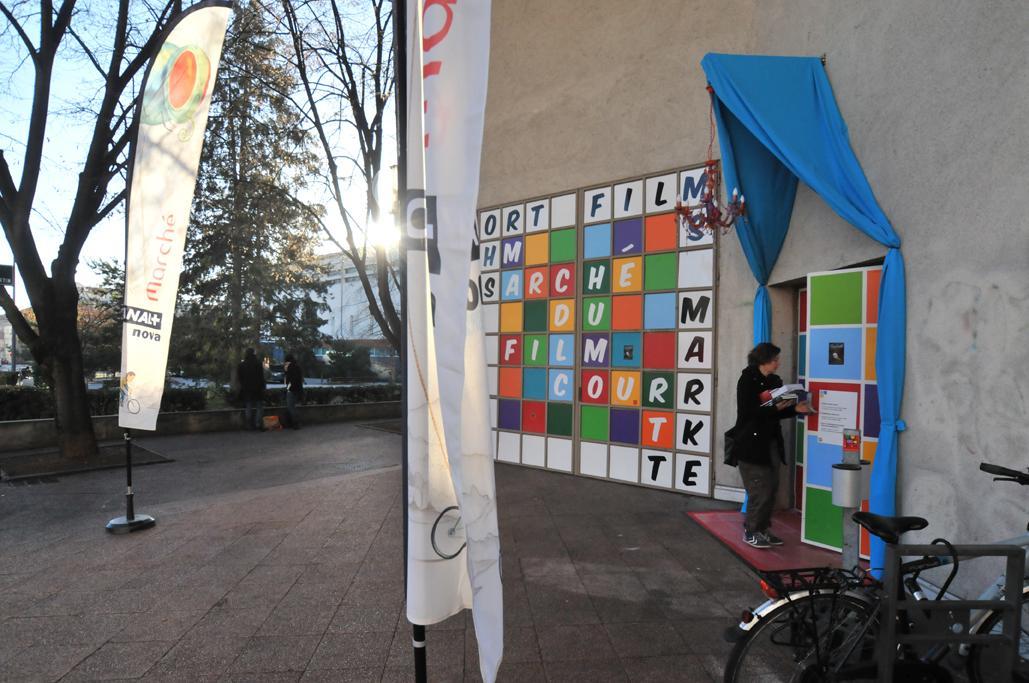30th Short Film Market
Damn, thirty years already!
Thirty years. Flies by so quickly, and yet…
The Short Film Market saw the light of day in 1986. First held in Salle Gaillard, then in the Maison de la Culture in Salle Chavignier, the Market consisted of three viewing booths in a small office made available to a handful of buyers. Among them, the Canal+ team with Alain Burosse, Patrice Bauchy and Pascale Faure, France Télévisions with Alain Gauvreau and Roland Nguyen and finally La Sept ARTE with Barbara Habe, who was succeeded by Hélène Vayssières a few years later.
Alain Gauvreau was responsible for the acquisition of short and feature-length films at the time. It was Alain who established Histoires Courtes, on France 2. As for Roland, he introduced La nuit du court métrage. It was in 1986 that Alain Burosse delivered the first of a long series of Canal+ Awards, the beginning of a loyal partnership. Canal + championed shorts with the creation of programs like Surprise, then L’Oeil du cyclone, later Mikrociné and finally a collection of short films presented each year in Clermont-Ferrand. La Sept, who until then had a broadcast window on France 3, became Arte in 1992, with its slot for short film: Court-circuit. Let us take the opportunity to thank these television stations who have been active at the Short Film Market since the beginning.
Canal+ and the Short Film Market celebrate their 30th birthday: a long love story!
(exhibition “Le Fugitif”, festival 2014)
After 2 years spent in the Club d’affaires Gergovia, the Market spent one edition in the Hôtel Coubertin. This was when the first booths were set up: among them, several partners who would be with us for a long time, such as l’Agence du court métrage, Unifrance, the Swiss Film Center, and L’Agence Tout Court Belgium.
The major turning point came in 1996 with the move to Gymnase Honoré-Fleury, which allowed the newborn market to mature, evolve and grow – which was a real challenge at the time. The exhibition hall then counted 21 booths from 10 different countries. That first year, the venue seemed so large! The video library contained 18 viewing stations. The Market screenings multiplied. Also in 1996, the first paperback “market catalog” appeared. 1814 films were listed in its 480 pages. Many thanks of course to those first exhibitors, true pioneers of the Short Film Market, who contributed greatly to the reputation it enjoys today.
In 1999, the catalog was 608 pages long and counted 2238 films – and became known as the “Bible” in the short film circuit. The exhibition hall began to fill up, with nearly 30 booths from 18 countries. The Gymnase Fleury venue no longer seemed so large! 25 individual viewing stations were available to television buyers and distributors, for in 1999, this trade, which previously existed only for the feature-length film industry, began to develop and establish itself for the short film.
This is not meant to be a memoire on the evolution of the Short Film Market, but it is important to mention that in 1999, an American (short-lived) start-up by the name of ATOM Films appeared and turned the heads of all the Market professionals. What did they want exactly? Content. The short film took on increased significance as ATOM bought the films by the kilogram. Distributors began to worry, and perhaps rightfully so. ATOM bought the entire catalog of the sole American distributor, Forefront Films. The Short Film Market thus experienced first-hand the beginning of the digital era.
Short Film Market 2014
Over the last 20 years, the Market has strived to professionalize the short film, creating discussion forums about original music, educating filmmakers on the importance of music rights, and also encouraging encounters between composers and directors so that these filmmakers give increased priority to original music in their short films.
Finally, the Market would be nothing without the digital video library, which was created in 2003. At that time, only the National Library had adopted a digitization policy for French films (the legal deposit). They digitized in mpeg1, whereas the Short Film Market chose a brand-new standard: mpeg4. This digital video library was not only a technological revolution, but also a revolution of the mind, primarily for the professional users, but also for audiovisual market organizers.
Ahhh, the memories… but hey, thirty years isn’t nothing!
Lastly, we would like to greet the new Short Film Market 2015 exhibitors. A warm welcome to the Hong Kong Arts Centre (Hong Kong), the Kaohsiung Film Archive (Taiwan), the Clap! Film shooting assistance office (Belgium), and the Iranian Young Cinema Society.
Short film Market 2014
With the support of the MEDIA program, the Procirep and the CNC, over 3000 accredited visitors are expected for the 2015 Short Film Market, which once again asserts itself as the leading platform for the short film industry and for young cinema globally.










